You can tell you’re in an authentic Korean restaurant when they’re dishing out that spicy fish stew known as maeuntang (매운탕). While they often whip it up with cod, the beauty of this dish is that you can get creative and use any fish you fancy. Now, our twist on this classic – it’s crafted with pollock, which gives it the name Dongtae Jjigae / 동태찌개.
Unlocking the fantastic flavors of this stew is all about the secret seasoning duo: salted shrimp and anchovy sauce. But here’s the exciting twist – they frequently add some delectable shellfish to amp up the taste, either in the stew itself or the fish stock.
Now, as someone dealing with gout, I’ve had to bid farewell to ordering this mouthwatering dish at the restaurant. On the flip side, it means I get the opportunity to cook up my very own, incredibly tasty spicy fish stew!
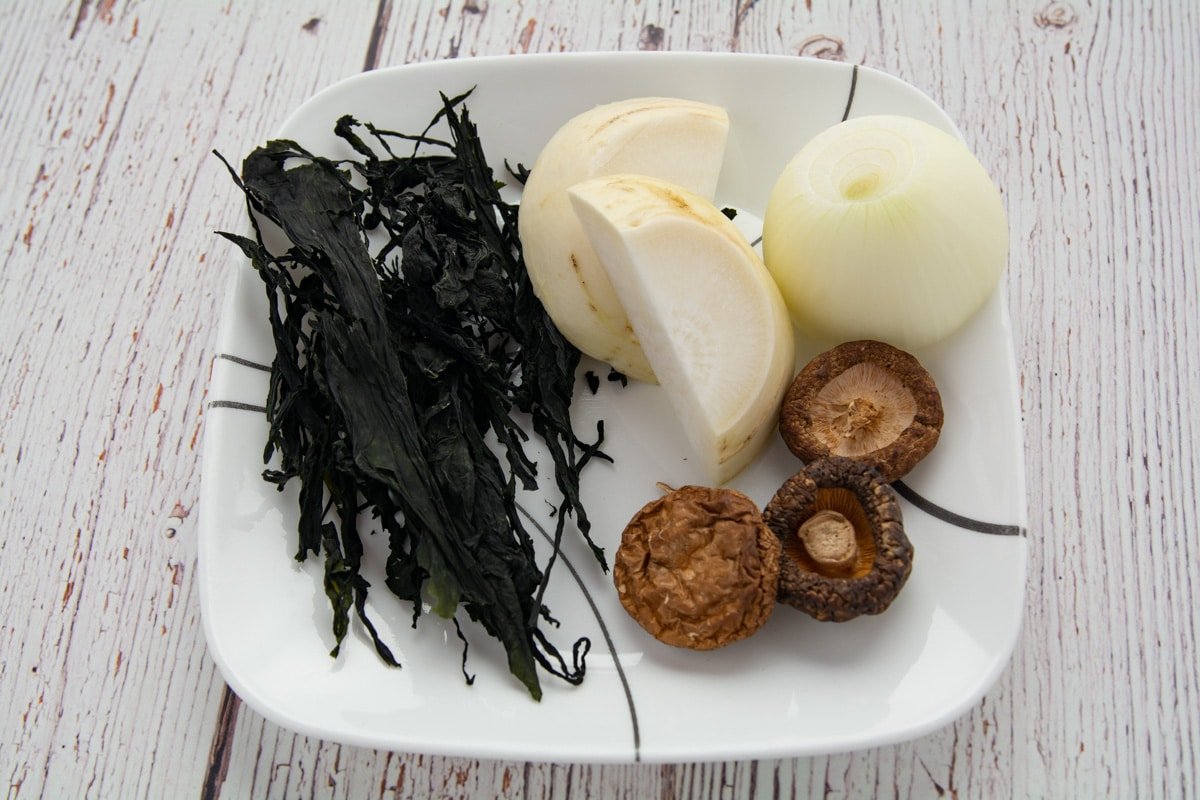
Because this version can’t include salted shrimp or anchovy sauce, we’re going for an umami-packed veggie stock instead. To achieve that, we’ll rely on the goodness of seaweed and shiitake mushrooms. However, if mushrooms are a gout trigger for you, no worries, you can skip them altogether.
Ingredients
Seaweed is commonly used in Korean vegetable stock to infuse a rich umami flavor. It adds depth and complexity to the stock, making it a fantastic alternative to the salted shrimp and anchovy sauce that are traditionally used in Korean cuisine. Seaweed is also a natural source of glutamic acid, which enhances the savory, or umami, taste in dishes.
Additionally, seaweed is a healthier option for those who want to avoid animal-based ingredients or have dietary restrictions. It’s a staple in Korean cuisine, known for its unique taste, nutritional benefits, and ability to elevate the overall flavor profile of the dish.
Dried shiitake mushrooms are packed with umami, which is the fifth basic taste known for its savory and rich flavor. When rehydrated and added to the stock, these mushrooms impart a deep, earthy, and meaty flavor that enhances the overall taste of the dish.
Onions add a natural sweetness and depth of flavor to the stock. When cooked, they release their natural sugars, caramelizing and providing a subtle sweet note that balances the umami from ingredients like seaweed and shiitake mushrooms.
Korean radish, also known as mu (무) has a mild, slightly sweet, and earthy flavor. It adds a subtle vegetable sweetness to the stock, enhancing its overall taste. The aroma of Korean radish also contributes to the pleasant fragrance of the stock.

To whip up your flavorful stock, let’s keep it simple and friendly:
- Prep Ingredients: Start by giving those mushrooms and seaweed a good wash. No need to be too fussy; just ensure they’re clean.
- Into the Pot: Next, throw the seaweed, mushrooms, onion, and that trusty Korean radish into a pot. Cover them with water, and let the fun begin.
- Simmer Away: Fire up the stove, bring everything to a simmer, and let it gently bubble away for about an hour. Keep an eye on it and add more water if needed. Here’s a little trick: if you use around 1.5 liters of water and reduce it by about 30%, you’ll end up with a perfectly hearty liter of umami-rich veggie stock.
- Cool Down and Strain: Once you’ve let the magic happen, allow your veggie stock to cool down. Now, it’s straining time. Bid farewell to the onion and seaweed; they’ve done their job and can go into the bin. Hang on to that trusty radish and those tasty mushrooms, though. The radish can be turned into a delightful side dish, and those mushrooms are destined for greatness in your stew. Enjoy the culinary adventure!
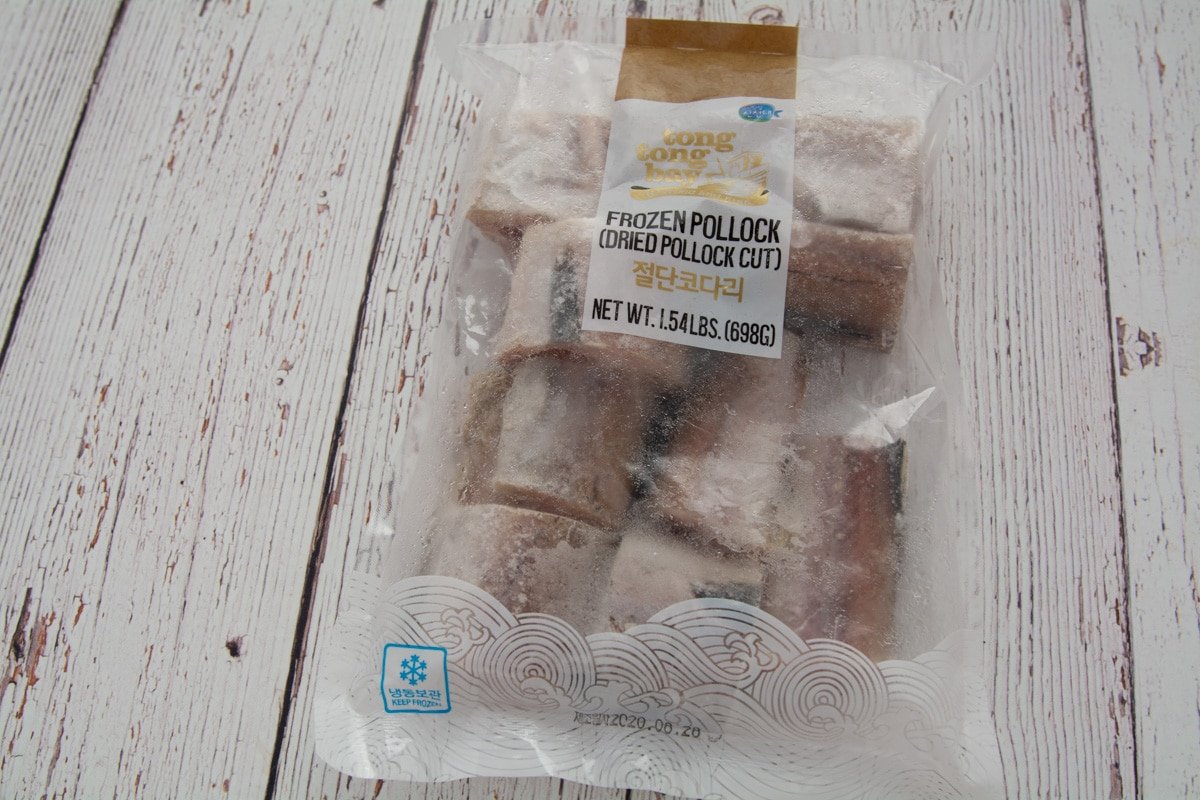
To cook up a fantastic pollock stew, or as we call it, “dongtae,” you’ll need some pollock, of course. My secret? I prefer to grab frozen, pre-cleaned pollock. Trust me; it’s a real time-saver. When you buy the whole fish, sometimes you’re left dealing with scales and all that. But let’s be real, who has the energy for that?
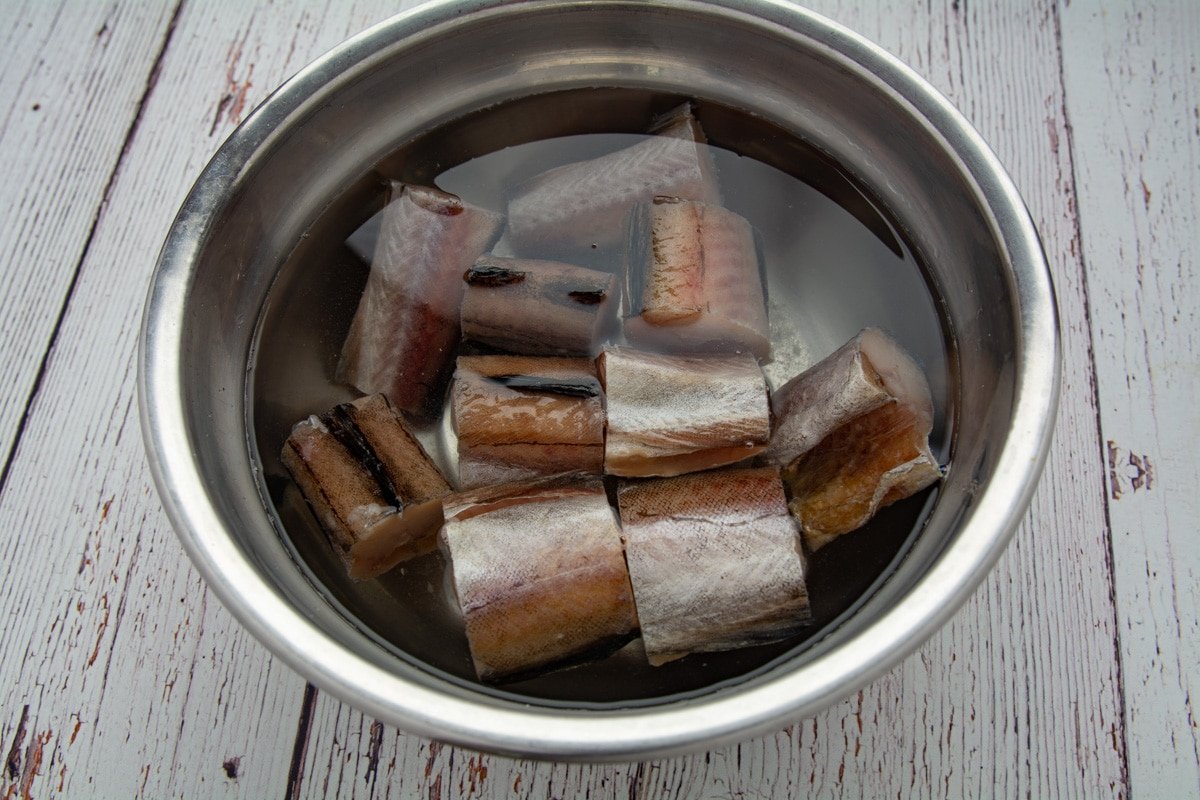
To give your fish a little TLC and get rid of any unusual odors, here’s a friendly tip: cover the fish with some saltwater. Let it soak in that salty bath for about an hour, and then give it a good rinse in clean water. Your fish will be fresh and ready to go!

Let’s talk about the veggies for our stew pot, shall we?
Korean Radish: You bet, we’re tossing in some more of that fresh and crunchy Mu! It’s going to add a delightful twist to our dish.
Onion: Oh, you know it! Fresh onion is making its grand entrance, adding its distinct flavor to the mix.
Cabbage: Now, here’s where things get interesting. Some folks like to add onion, and I was all in for that plan. But my lovely wife had her own ideas, and the onion got the boot. The choice is yours – you can follow your heart and choose to add it or not. It’s all about making this stew your own culinary masterpiece!

Let’s chat about the extra ingredients for our stew:
Bean Sprouts: Now, I’ll be honest, these bean sprouts might look a bit sad, but don’t let appearances fool you. They bring a fantastic texture and flavor to the stew. Some folks like to toss them in early, but I prefer adding them later to keep that satisfying crunch.
Tofu: Ah, tofu, the flavor sponge! It soaks up all those amazing flavors as it simmers in the rich broth. But here’s the deal: if tofu’s texture isn’t your thing, feel free to skip it. Just be warned, if the “Korean food police” ever come knocking for your tofu omission, you’re on your own! 😁
Mushrooms: Variety is the spice of life, right? We start with the shiitake mushrooms we used for our stock, and then we add in others. Today, we’ve thrown in some king oyster mushrooms. Enoki or button mushrooms are also top-notch choices. The more, the merrier!

Let’s talk about the finishing touches for our dish:
Ssuk-gat (Crown Daisy): So, that herb you see in the picture? It’s called ssuk-gat, or crown daisy, and it packs a real flavor punch. I used a whole bunch, but my wife insists that only one stalk would’ve done the trick. If you want an alternative with a fresher taste, keep an eye out for minari, or water dropwort. It’s a bit harder to find but worth it.
Green Onion: Oh, we can’t forget the green onions! This dish is all about the green onion goodness. The more, the merrier!
Spicy Peppers: Today, we went with the zesty green Korean peppers, but red ones work like a charm too. If you can’t lay your hands on the Korean varieties, don’t sweat it – jalapenos make a fantastic substitute.
It’s all about personal preferences and what’s available in your kitchen. Spice it up your way!
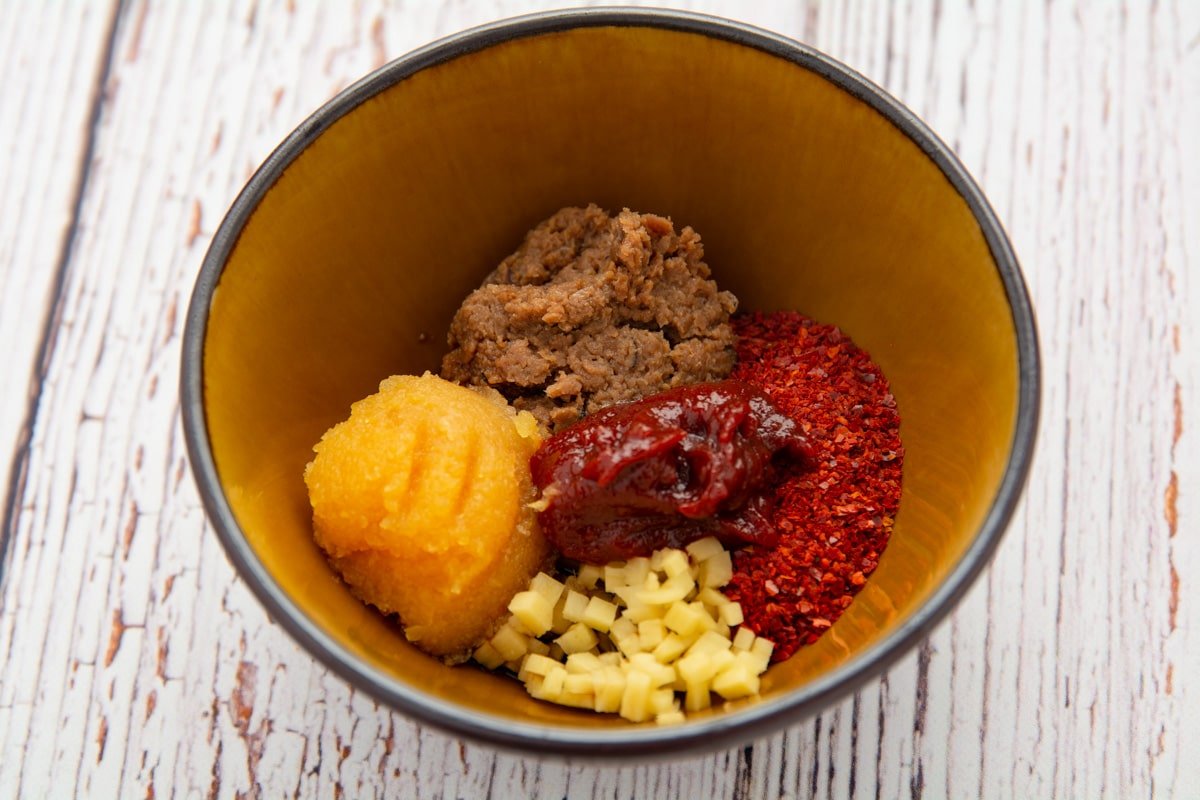
Now, let’s get ready for the seasoning paste – a key part of our dish:
Mix Ahead for Ease: To keep things stress-free in the kitchen, I like to prepare all my seasoning ingredients in advance. You can even do this a day or two ahead of time, which is a real time-saver.
Korean Soybean Paste (Doenjang): Ah, this one’s a game-changer! Doenjang, a fermented delight, brings a serious umami punch to the table. It’s the secret to that fantastic depth of flavor.
Soy Sauce: Here’s the beauty of making doenjang – you also get soy sauce as a byproduct, loaded with umami goodness. On some Korean cooking blogs, they might specify using soup soy sauce, which is a bit stronger, but don’t stress if you’ve got the regular kind. Use what you have.
Korean Red Pepper Flakes (Gochugaru): Gochugaru is as simple as it gets – ground-up dried chili peppers. We do have our preferences when it comes to brands, with Korean ones topping the list, but those from China work just fine.
Korean Red Pepper Paste (Gochujang): Gochujang, a delightful blend of rice, peppers, and sweetener, adds a lovely sweet and savory kick to the dish. It’s optional, not everyone uses it, but since we’re skipping the salted shrimp, we’ll take all the flavor we can get.
Garlic: You guessed it – loads of garlic. The more, the merrier!
Ginger: And ginger galore! It pairs perfectly with fish and helps cover any fishy smell.
Mix up all these fantastic ingredients for your seasoning paste, and keep them ready for a hassle-free cooking adventure.

Time to spice things up with some more details:
Korean Red Pepper Flakes (Gochugaru): Gochugaru is our star here. We’ve already added some to the seasoning paste, but now we’re taking it a step further. We’ll toast a bit in sesame oil, which gives it a slightly different flavor.
Sesame Oil: Toasting gochugaru? You’ll want sesame oil for this. It adds a rich, nutty dimension to the flakes.
If No Toasting: If toasting isn’t your style, no worries. Just add the red pepper flakes and sesame oil directly to your seasoning paste.
Rice Flour: Now, this one’s optional. You can mix some rice flour with water, and I’ll let you in on a little secret: I initially thought it was a tablespoon, but my wife insists it’s just a teaspoon. However, as a pro tip, I’ll let you know that I’m going to skip it from now on and simply use the water from rinsing rice. It’s a nifty shortcut!
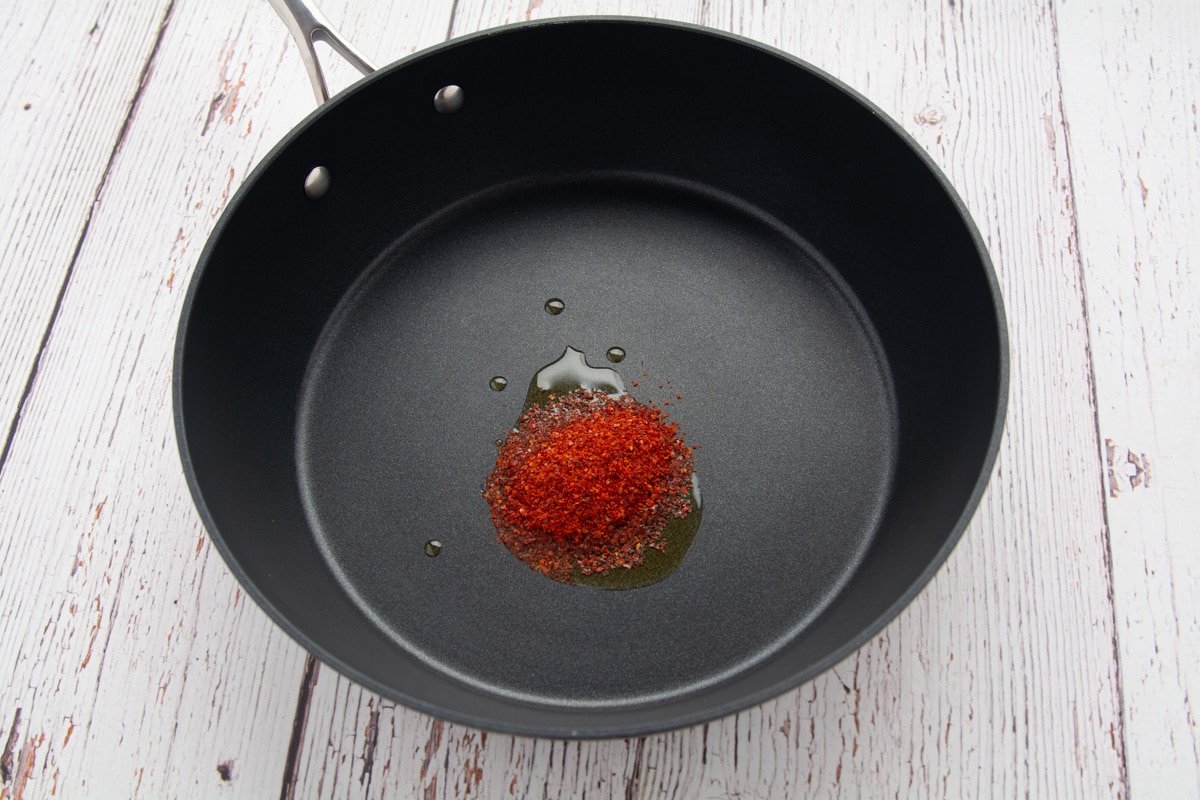
Time to toast those red pepper flakes – it’s a breeze! Here’s how:
Toasting Method: In a pan over low to medium heat, add the sesame oil and your red pepper flakes.
Easy as pie, right? Enjoy that lovely, toasty flavor!
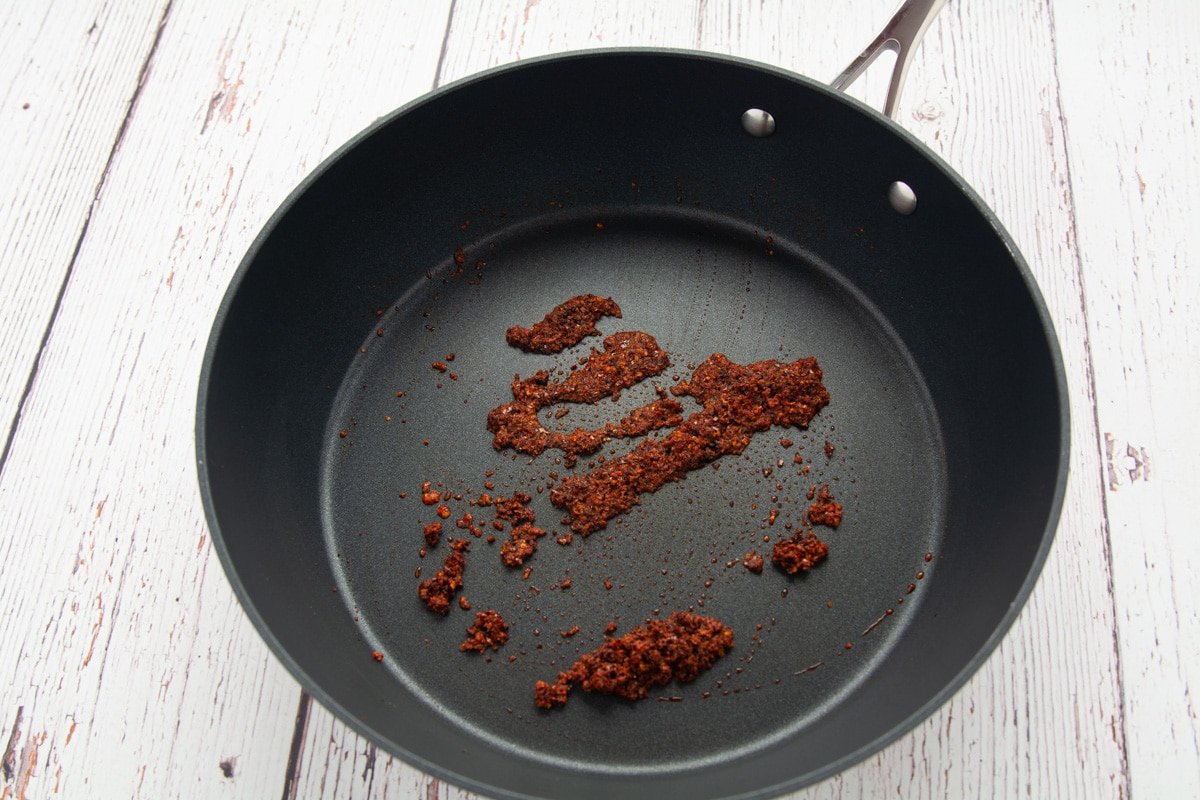
Great, you’re on the right track! Keep stirring those red pepper flakes in the sesame oil until they start to pick up some color and you get that delightful aroma. But remember, they can be a bit tricky and burn quickly, so keep a close eye on them. If they do start to burn, don’t hesitate to toss them out and start fresh. Safety first, and you’ll get the perfect toasty flavor in no time!
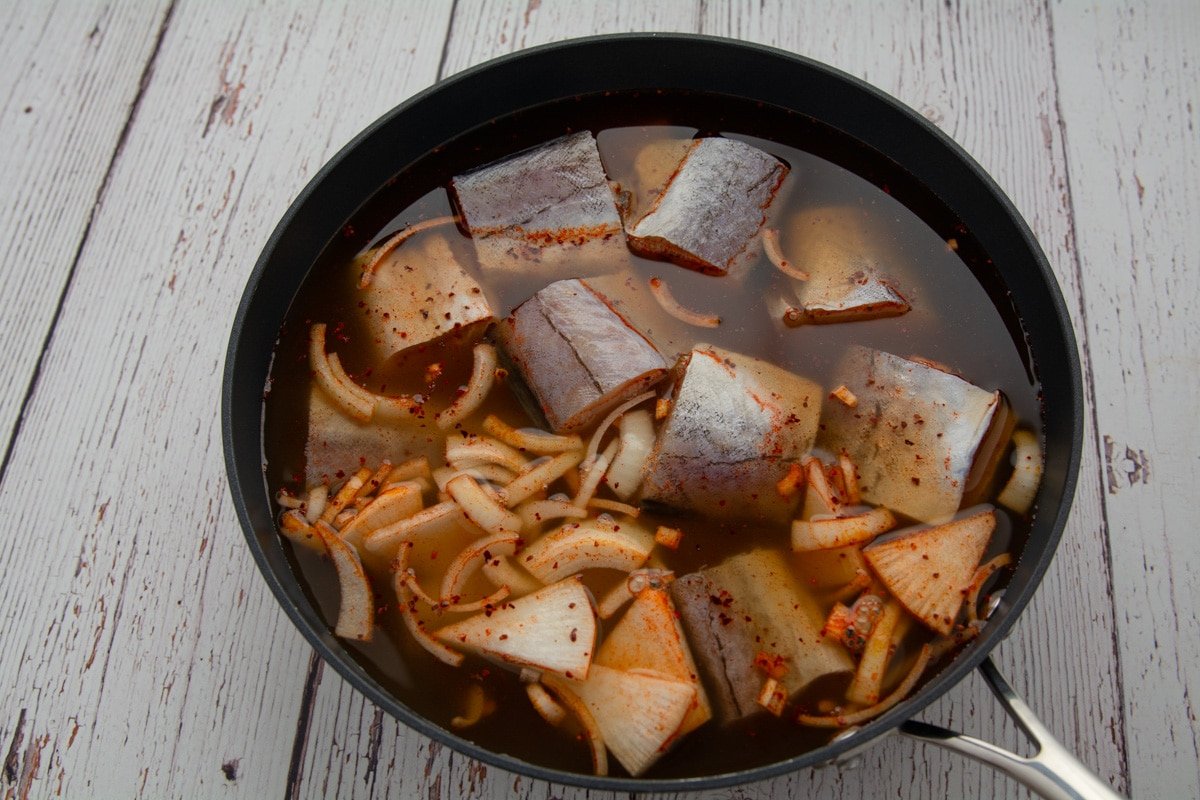
Now, let’s bring all those fantastic ingredients together:
Toasting Check: Once your red pepper flakes have that lovely color and aroma, it’s time to add in the onion, radish, fish, your veggie stock, and enough water to almost cover the fish.
Liquid Mix: In total, I used two liters of liquid: one liter of that umami-rich veggie stock we talked about earlier and one little trick – one liter of the water from washing rice. That rice water has a special secret; it helps make our stew thicker, giving it that perfect consistency.
Bring everything to a simmer and let the magic happen!

Let’s keep it simmering to perfection:
Slow Boil: Now, we want to bring our stew to a gentle boil. Once it’s bubbling away, it’s time to introduce the seasoning paste. That’s where the real magic of flavor happens!
Cooking Time: Keep an eye on that radish; when it’s tender, that’s your cue that the fish should be perfectly done. For me, it usually takes around twenty minutes. It’s all about that patience and the reward of a delicious stew at the end!

At the fifteen-minute mark, let’s give it a taste and do some fine-tuning:
Taste Test: Grab a spoon and have a little taste of the stew. This is where you can adjust the seasoning to your liking. I usually add about one tablespoon of soy sauce and one teaspoon of sea salt to hit that perfect flavor balance.
Fine-tuning: Once you’ve got the seasoning just right, it’s time to add in the tofu, those crunchy bean sprouts, and those flavorful mushrooms. They’re the final touches that make this stew truly special. Enjoy the final steps of this delicious journey!
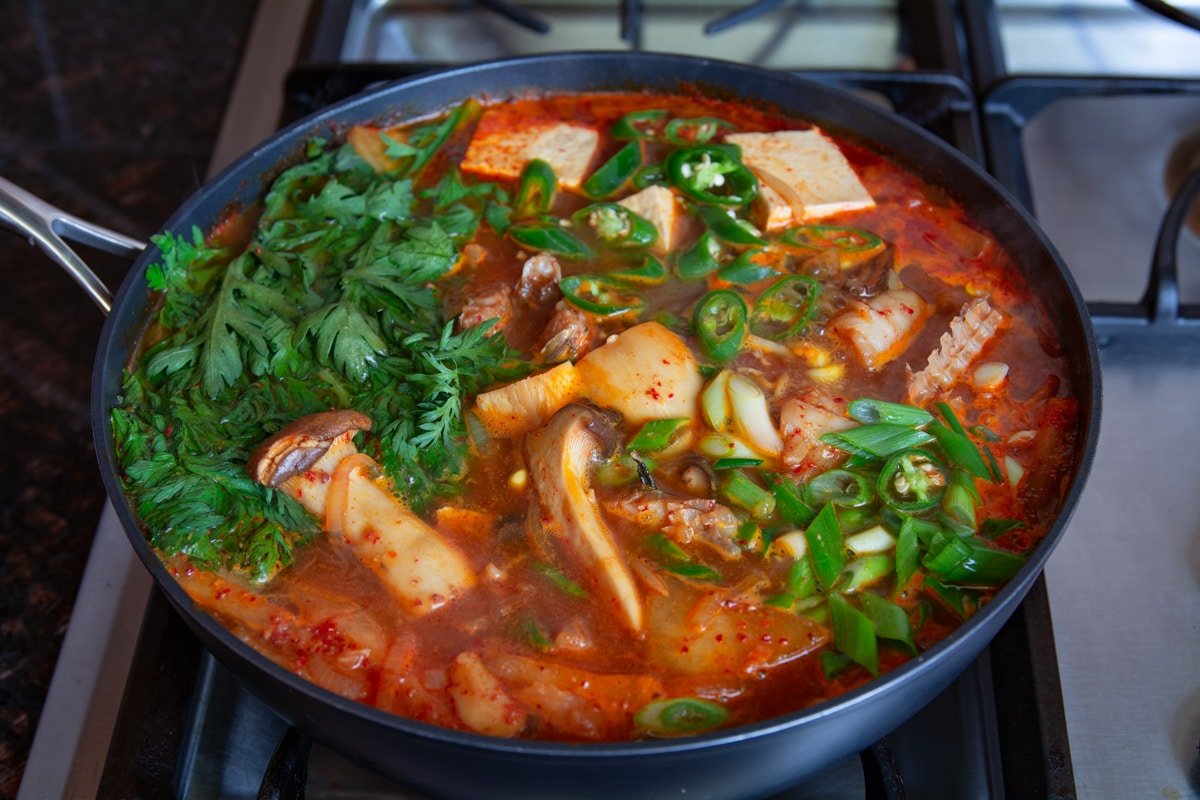
We’re almost there, and it’s the finishing touches that make all the difference:
Right Before Serving: Just as you’re getting ready to dish up this mouthwatering creation, toss in the ssuk-gat, loads of green onions, and those zesty peppers. They add that fresh, vibrant kick that takes the stew to the next level.
Spicy Note: Oh, and don’t forget, this one’s packing some heat, so keep that rice and water close by. You might need them to cool down, but the spicy journey is oh-so worth it!


Ingredients
Veggie Stock
- 5 grams Ottogi seaweed
- 3 Shiitake mushrooms Dried
- 200 grams Korean radish Mu
- 1 Onion medium
- 1.5 Liters Water
Fish
- 1.5 pounds Pollock
Vegetables
- 200 grams Korean radish
- 1/2 Onion
- 8 oz Tofu
- 150 grams Bean sprouts
- 200 grams Mushrooms
- 1 sprig Ssuk-gat Or one bunch of Minari
- 4 Green onions
- 2 Green peppers
Seasoning paste
- 1 Tablespoon Korean soybean paste
- 1 Tablespoon Korean red pepper flakes
- 1 Tablespoon Korean red pepper paste
- 1 Tablespoon Garlic
- 1 Tablespoon Ginger
- 1/2 Tablespoon Soy sauce
Other
- 1 Tablespoon Sesame oil
- 1 Tablespoon Korean red pepper flakes
- 1 Liter Water
Instructions
Make the veggie stock
- Wash the dried shitake mushrooms and seaweed
- To a pot, add the mushrooms, seaweed, one onion, Korean radish, and 1.5 liters of water.
- Simmer the stock until it has reduced by 30%
- Strain the stock and chopup the mushrroms.
Prepare the fish
- Soak the frozen fish in saltwater for 1 hour
- Rinse the fish in freshwater and sit aside
Prepare the veggies
- Chop up the Korean radish, onion, tofu, green onions, peppers, and mushrooms.
- Wash the beansprouts and Ssuk-gat.
Make the Seasoning paste
- Mix all seasoning paste ingredients, including Korean soybean paste, soy sauce, red pepper flakes, red pepper paste, garlic, and ginger.
Cook
- On medium heat, toast 1 tablespoon of red pepper flakes in 1 tablespoon of sesame oil.
- Add 100 grams of sliced radish, 1/2 medium onion, fish, 1 litter of veggie stock, and 1 liter of water. Bring to a slow boil.
- When the pot comes to a boil, add the seasoning mix.
- After 10 to 15 minutes, adjust seasoning. Add salt and soy sauce to taste.
- Add the tofu, bean sprouts, and mushrooms.
- When the radish is tender, add the Ssuk-gat, green onion, and green peppers. The stew is now ready to serve.

You are amazing! from South Korea
Thank you!